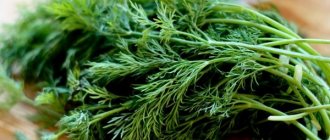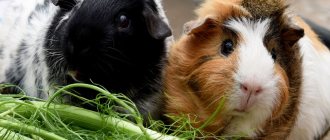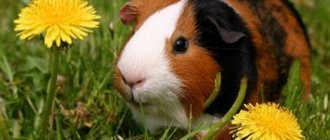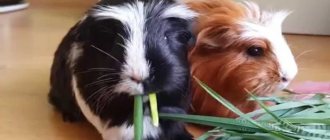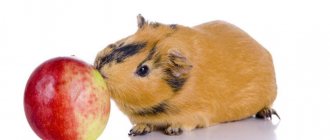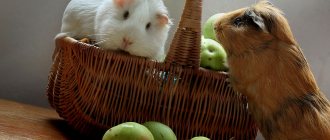- home
- Guinea pig
- Guinea pig nutrition
02/18/2019 Plant foods form the basis of the diet of guinea pigs, but even with obviously healthy products you need to be careful when it comes to feeding your beloved pet. It is worth considering whether guinea pigs can eat greens such as parsley and dill, and other similar plant products.
Dill
Dill contains carotene, thiamine, ascorbic acid, pectin, minerals and vitamins. Dill is good for digestion - it reduces the formation of gases in the intestines, suppresses putrefactive processes, improves appetite and digestion, and stimulates milk production. The leaves and stem can be given, but only in small quantities due to the essential oil content. During pregnancy, it is better to reduce your dill consumption.
Thus, the answer to the question “can guinea pigs eat dill” is yes, it is definitely possible and necessary to introduce dill into the diet of a domestic guinea pig.
For cats
For full development, cats must have a balanced diet. To do this, the food should include various greens, including dill. This spicy herb brings invaluable benefits to the animal’s body:
- normalizes intestinal function;
- improves lactation in lactating cats;
- corrects the functioning of the genitourinary system;
- removes sand from the kidneys and bladder;
- increases immunity.
Dill should not be given to pregnant cats, as the substances contained in it cause contractions of the uterus, which can cause miscarriage.
In addition, it should be excluded from the diet if the animal has problems with the endocrine system. It is best to give dill to cats by mixing it with the main food in a ratio of 1:5.
Parsley
Parsley contains a lot of vitamin C and A, minerals; root parsley contains vitamins A, C, PP and group B. The root and green parts are suitable for guinea pigs to eat. The essential oils contained in parsley have a beneficial effect on the digestive system.
Parsley stimulates contraction of the uterine muscles and can cause premature birth, so this greenery should not be fed to pregnant females. Also, parsley is not recommended for consumption by lactating females, as it negatively affects lactation. So can a guinea pig eat parsley?
This greenery should be given to your pet in small quantities; parsley is toxic in large quantities.
Two approaches to feeding guinea pigs
When it comes to choosing a diet for furry rodents, the opinions of owners and breeders are divided.
Some believe that dry food containing grain and pressed granules from cereals and grass is contraindicated for guinea pigs, since the basis of their menu should be hay, grass and succulent food.
Adherents of dry food claim that ready-made food from well-known manufacturers contains all the necessary elements and ingredients for animals, and in limited quantities, grains are even beneficial for them.
In fact, these two options have both advantages and disadvantages, so each owner must decide for himself which type of feeding to give preference to.
Option 1: Grain-free diet
The main part of this diet consists of hay and fresh grass. As an additional food, fans of grain-free feeding give guinea pigs pieces of vegetables and fruits and berries twice a day.
A grain-free approach to guinea pig nutrition includes a wide variety of vegetables.
What to consider when choosing this type of feeding:
- The pet's menu should be varied, so every day succulent food should include five types of vegetables and fruits. For example, on the same day you can give your guinea pigs slices of zucchini, carrots, peppers, apples and raspberries. And on the second, feed with pieces of pumpkin, turnip, cucumber, pear and blueberries.
- Vegetables and fruits must be environmentally friendly. It is unacceptable to give pets foods treated with chemicals.
- Uneaten slices of vegetables and fruits must be removed from the cage immediately. Otherwise, the process of rotting begins in them and, after eating such a product, the pig may become poisoned.
Among the advantages is the fact that the owner will not need to spend money on purchasing ready-made grain or granular mixtures.
If we talk about the disadvantages, the owner will have to make sure that there are several types of fresh fruits and vegetables in the refrigerator all year round, but in winter this is quite problematic and costs the owner a lot of money.
Option 2: feeding grain or pelleted mixtures
The grain approach to feeding pigs involves only one tablespoon of grain per day, the rest is vegetables and hay.
What you should know when choosing this type of food:
- You should buy dry mixtures only from trusted manufacturers. Cheap food contains a lot of grains and dried sweet fruits, which are harmful to the health of the animal;
- The guinea pig is given no more than a tablespoon of dry food per day and must supplement the diet with juicy food;
- if the animal is not accustomed to dry food, then the pet should be accustomed to it gradually, starting with half a teaspoon per serving;
- Such food is quite high in calories, so it is not advisable to feed dry mixtures to rodents that move little.
The advantage of grain food is that it is hard, so it helps the animal grind its teeth.
If we talk about the downsides, high-quality food is quite expensive. Another disadvantage is that such food can be difficult to find in a pet store and often has to be ordered on Internet sites.
Salad
Can guinea pigs have salad? The answer is clear: yes, guinea pigs can be given all types of lettuce. This plant is early ripening - a month to a month and a half after sowing, a rosette of succulent leaves is formed, which can be fed to guinea pigs. Lettuce leaves are a source of almost all vitamins - A, C, P, E, K, group B, as well as potassium, calcium and iron salts. Due to this content of vitamins and minerals, lettuce leaves help enhance digestion and metabolism in the pet’s body. You need to feed your guinea pig only fresh leaves, because the lettuce spoils in a very short time. Do not feed lettuce to a pig who is not accustomed to greens. Also, you should not feed your pet greenhouse greens due to the high amount of nitrates.
Where to collect and how to properly process herbs
Grass for guinea pigs should be collected exclusively in clean areas, away from landfills, garbage cans, busy highways, and industrial facilities. Do not store grass and tree cuttings where dogs are walked or livestock is grazed .
Did you know? When stroked by the owner, the guinea pig can sometimes make sounds similar to the purring of a cat.
Near fields and vegetable gardens, where plots are often fertilized with pesticides and nitrates, it is also prohibited to collect greens for pets. In places where there are a large number of trees (forest, grove, park), stocking up on food is also not worth it, since ticks may accumulate there. The grass should be picked in an open meadow, away from all possible sources of pollution.
Spinach
You can feed your guinea pig baby spinach casts, which contain a wide variety of vitamins, protein, potassium salts, iron, calcium and phosphorus, but only in very small quantities and not often. Because in addition to vitamins and minerals, spinach contains a large amount of oxalic acid. And all products containing acid, such as sorrel, rhubarb, sorrel, can cause harm to your pet. Therefore, it is better to stop feeding your pig these greens and offer your pet lettuce leaves.
What can you feed your guinea pig?
Kevi have a special digestive system. Roni food is consumed frequently and in small portions.
Juicy food
Juicy food includes vegetables, fruits and berries. This is not the main food for guinea pigs, but is necessary for maintaining an active lifestyle and health.
With vegetables, the body receives the necessary amount of fiber, which promotes the functioning of the digestive system. When eating fruit, the guinea pig receives the necessary vitamins.
What can a guinea pig eat from vegetables, fruits and berries:
- Carrot;
- Zucchini;
- Cucumber;
- Pumpkin;
- Beet;
- White cabbage;
- Cauliflower;
- Bell pepper;
- Turnip;
- Swede;
- Sweet corn;
- Tomatoes;
- Green pea;
- Apples;
- Pears;
- Citrus;
- Apricots;
- Nectarines;
- Peaches;
- Plum;
- Pitted cherries;
- Raspberries;
- Strawberries.
Before feeding your animal a new vegetable or fruit, it is better to consult a veterinarian.
You should give from 3 to 5 different vegetables and fruits per day. Alternate them every day
However, it is important to give them to your guinea pig correctly. Either several types of vegetables at one time, or several types of fruits. For example, you should not feed plums and beets at the same time.
For example, you should not feed plums and beets at the same time.
The daily food intake is divided into 2 or 3 meals. It is better to feed succulent food in the first half of the day.
In the afternoon, you can give mainly green food and hay.
Hay and green fodder
Hay should always be in the feeder. You can prepare it yourself, or purchase it ready-made at a pet store.
You can make your own hay from meadow grasses.
Green fodder cannot be collected along the road. It is better to collect grass in a field or forest. To make hay, it must be dried for 1-2 months.
The grass should not be wet, rotten or rotted. Before feeding green food to an animal, it must be washed and dried.
Guinea pigs are herbivores. They chew hay constantly. They need it to grind down their teeth and normalize the digestive system.
What herb can you give:
- Nettle;
- Plantain;
- Dandelion;
- Alfalfa;
- Clover;
- Chamomile;
- Yarrow;
- Carrot tops;
- Beet tops;
- Raspberry leaves;
- Strawberry leaves;
- Currant leaves;
- Dill;
- Parsley;
- Lettuce leaves.
Water
Water must be in the cage at all times. Do not use tap water. You can take bottled or filtered water.
What else can you give?
In order for a guinea pig to wear down its teeth, it must be given tree branches to chew on. Branches should be collected away from the road. Before feeding, the branches must be cleared of dirt and washed under running hot water.
Which tree branches can be given:
- Birches;
- Linden trees;
- And you;
- Apple trees;
- Pears;
- Cherries;
- Rowan trees.
In addition to food, the animal needs vitamins. The kewi's body is designed in such a way that it cannot obtain vitamin C from regular food. A lack of this vitamin leads to various diseases, so additional feeding is necessary.
One adult should be given 5-15 mg of ascorbic acid daily. The vitamin can be dissolved in a glass of water and poured into a drinking bowl.
How much should you feed?
You need to feed your guinea pig 2 or 3 times a day. In this case, the daily feed intake is divided into 2 or 3 times, respectively.
In the first half, most of the succulent feed, part of the hay and granulated feed are fed. In the second half there are the remains of succulent food, a lot of hay and the remains of granulated food.
If you increase the dose of pelleted food, this can lead to obesity.
Celery
You can pamper your pet with celery leaves and roots, but only in small quantities and grown in your own area. Celery stimulates the secretion of gastric juice and improves water-salt metabolism. Celery should not be fed to pregnant females or animals suffering from kidney stones.
Results
In conclusion, I would like to say that not everything that your guinea pig eats will be good for it. Do not try exotic products on her. If you don’t know whether your guinea pig can eat this or that product, it’s better not to feed it. A rodent in captivity cannot distinguish between products that are not healthy for it and therefore will eat everything you offer. On forums you can often see messages that some owners' guinea pigs eat almost all the foods on the prohibited list. But do not experiment on your pet; give him only vegetables, grass, herbs and fruits growing in our country. Believe me, without oranges, tangerines, bananas, kiwis and other harmful fruits, they will survive and live a long and happy pig life, delighting you.
Melissa
Melissa, like mint, can be fed to guinea pigs only in limited quantities. Melissa stimulates digestion, has an antispasmodic effect and helps with stomach diseases.
Sometimes you can diversify your guinea pig's diet with a small amount of:
- basilica,
- marjoram,
- rosemary,
- thyme,
- tarragon and other herbs.
Thus, summing up our article and answering the question of whether guinea pigs can have dill, parsley and other herbs, let’s say the following.
If you live in an apartment and cannot offer your pet fresh grass, you can replace it with greens. Greens contain large amounts of vitamin C, which is essential for guinea pigs. In the summer, you can buy fresh herbs at the market, but in winter you can try growing greens on a windowsill or, which is much healthier, germinating wheat and oats.
Did you like the article? Share with friends: [supsystic-social-sharing id=”1"]
- Related Posts
- How to choose a guinea pig
- What vegetables can guinea pigs eat?
- Guinea pigs
« Previous entry
Rules for collecting and preparing green feed
After a long winter, it is not recommended to give guinea pigs a lot of juicy green grass at once. The body may not be able to cope with the abundance of lush greens.
As a result, the breeder will suffer serious problems - from indigestion to seizures and disruption of the cardiovascular system. Young grass and shoots are rich in potassium, which causes health problems. After the winter months, fresh, succulent food should be introduced into the diet gradually and little by little. If it turns out that they gave too much grass and the animal has indigestion, then in the next few days it is recommended to exclude any succulent food from the diet and give the guinea pig rice water to drink.
It is very important to understand that to feed animals, grass and tree branches should not be collected in places where pets walk or livestock graze, near roads and garbage dumps, near factories and large enterprises, and also where the land is treated with pesticides. You should also not collect grass in parks and forests where there are a large number of ticks. The collected grass does not need to be washed if the breeder is sure that the collection area is clean. However, if there is any doubt that the grass is too dusty or may contain any other contaminants, then it is better to rinse it under warm running water. It is not recommended to treat fresh grass with very hot water or boiling water. Short treatment does not kill eggs and larvae of worms and other parasites, but heat treatment will negatively affect the content of vitamins and all nutrients.
Herbal mixtures are stored in a regular bag in the refrigerator for a week.
If the goal is to harvest grass for the winter, then you should first chop it finely and put it into portioned bags, which are placed in the freezer. However, it is much easier and better to dry the grass for the winter. To do this, the collected succulent feed is laid out on a flat surface in a shaded and well-ventilated area. Hay can be stored for up to four to five months without losing its taste and beneficial properties.
Ducklings
In order for duck chicks to quickly gain weight, it is recommended to feed them not only dry granulated food, but also prepared food yourself.
Feeding ducklings with herbs, including dill, is allowed from the first days of life. Dill promotes the rapid growth of ducklings, protects them from diseases and strengthens the skeleton. Finely chopped greens are mixed with a boiled egg and chopped shells in a ratio of 1:4 and given to the ducklings once a week. It is not recommended to feed chicks this grass more often, as it can cause intestinal upset and dehydration.
Grain feed
A guinea pig needs to eat at least 20% grain per day. Grain food for rodents is sold in any pet store. The finished product usually includes:
- barley;
- oats;
- millet;
- sunflower seeds;
- corn grains.
In addition to grain, prepared feeds may include vegetable granules and vitamin supplements.
Dry pet food is easy to prepare yourself; you just need to buy different types of grains on the market and then mix them. But you need to take into account that the main ingredient is oats; guinea pigs eat it more readily than other grains. Solid grain food should always be present in the diet of rodents. Animals need it to grind down their continuously growing teeth. If a rodent eats only raw and soft food, then its incisors become unnaturally elongated and interfere with the ability to absorb food. As a result, the animal dies from starvation.
Rough (solid) feed
Rough (solid) food is primarily hay, grain and special pellets (pelleted food, which is sold in pet stores).
You can easily do without the latter, but it is very convenient to use and helps out in many cases, especially in winter. Guinea pigs usually crunch with pleasure at such gourmet incas right there, like chickens in a backyard, they rush to the feeder, clinging to it from all sides until they find it and eat everything that they love most. Currently, ready-made, pre-mixed dry food granules have appeared on the market, specially prepared for guinea pigs, which contain added vitamin C. It must be taken into account that due to the addition of vitamin C, the food usually has a short shelf life, about 3 months. Such food must always be stored in a dry place and in tightly closed packaging, otherwise it will quickly become moldy and spoil. Good hay
is a so-called stimulant that prevents intestinal dysfunction in pigs. It should also be very fresh, not small or dusty and fresh-smelling. The hay should be without any coarse or large twigs, and for long-haired pigs, it is better to give the hay cut or rolled into a roll or tied. Otherwise, long hair gets tangled in the hay very easily.
Kuram
Greens should be a must in the diet of chickens , as they are the main source of nutrients. Dill normalizes intestinal function in chickens and strengthens the immune system. In summer it is given fresh, in winter – dried.
Since this herb has a diuretic and laxative effect, the bird should be fed it no more than once a week. You can add finely chopped dill to the main food or give it whole, hanging it over the feeder in small bunches.
Other products
Bread
Can guinea pigs eat bread? It's better not to give.
- Fresh yeast bread takes a long time to digest and causes fermentation in the animal’s stomach.
- White bread causes bloating.
- Your pet can eat stale bread, but not often.
- Dried bread with seeds, sesame seeds and raisins can sometimes be offered to your pet as a treat.
Can guinea pigs eat nuts and seeds?
Nuts and seeds are among the allowed foods, but can cause obesity if their consumption is not limited. It is better to offer your pet almonds, walnuts or hazelnuts.
The seeds contain many components useful for the animal: fatty acids, calcium, sodium, phosphorus, proteins and vitamins. It is better to give peeled seeds and make sure that they are no more than 15% of the total feed.
What vegetables can you give?
In order for succulent food to benefit your guinea pig, you need to familiarize yourself with the list of permitted vegetables. These foods contain large amounts of vitamins and minerals.
Zucchini
Introducing young zucchini fruits into your guinea pig's diet will bring great benefits to your pet. The vegetable contains a large amount of vitamins, minerals, and fiber. The composition contains sugars that do not exceed the permissible limit.
Carrot
The root vegetable is considered the main source of beneficial microelements. It includes:
- vitamin C;
- vitamin K;
- B vitamins;
- vitamin E;
- pectin;
- carotene.
Nutrients help improve metabolism, maintain normal vision and hearing. Microelements have a positive effect on the condition of the skin and coat. You can feed your guinea pig not only root vegetables, but also tops containing vitamins and minerals.
If carrots make up the majority of the diet, your guinea pig's urine will turn bright orange.
White cabbage
The vegetable is on the list of permitted ones, but it can only be fed to absolutely healthy pets. If the animal is prone to developing diseases of the gastrointestinal tract, eating cabbage can cause flatulence and diarrhea.
The product is introduced into the diet in small portions so that the rodent gradually gets used to it. If you feed a large amount of cabbage at once, health problems cannot be avoided. In addition to white cabbage, you can give small amounts of Brussels sprouts, kohlrabi and broccoli.
cucumbers
The vegetable consists of 95% water. The rest of the composition is occupied by:
- proteins;
- cellulose;
- Sahara;
- vitamins and minerals.
Cucumbers are not considered a nutritious food, but they have a positive effect on digestion. Overfeeding a rodent with vegetables increases the risk of developing digestive disorders. A small amount of the product is allowed for consumption.
Pumpkin
Pumpkin is considered a healthy vegetable, which includes:
- cellulose;
- proteins;
- vitamins;
- Sahara;
- useful micro- and macroelements.
Not only the pulp is included in the diet, but also the peel and seeds. Pumpkin helps normalize the gastrointestinal tract. Pumpkin seeds are given as a preventive measure against helminths.
Melon
It is permissible to introduce melon into the diet only at the height of the season. A small amount of ripe flesh is cut off from the guinea pig at a distance of at least 2 cm from the peel, since the largest amount of nitrates is concentrated near it.
You should not give melon to your guinea pig too often. The fruit contains a large amount of sugars that can lead to the development of diabetes in your pet.
Tomatoes
Includes:
- vitamin A;
- pectin;
- organic acids;
- vitamin C;
- micro- and macroelements.
Only ripe tomato pulp is introduced into the guinea pig's diet, since the unripe vegetable contains solanine. A high concentration of this substance can lead to the death of a pet. It is strictly forbidden to feed your guinea pig leaves. A large amount of tomatoes in the diet can lead to diarrhea.
Beet
The root vegetable is considered one of the healthiest for guinea pigs. Despite the benefits, beets are given in small portions, as they have a laxative effect. An excess of root vegetables leads to the development of diarrhea.
Beets are excluded from the diet of pregnant and lactating guinea pigs, as well as children under two months of age. The tops are of particular value. The pet eats it with pleasure. If you frequently feed beets, your urine may turn red.
Green pea
Feeding only fresh fruits is allowed. Introducing it into the diet together with pods is acceptable. Peas contain a large number of useful micro and macroelements and vitamins. Feeding in small quantities is allowed, as an excess of product will lead to bloating.
Jerusalem artichoke
The composition of the root vegetable includes:
- cellulose;
- lysine;
- arginine;
- leucine
It is allowed to feed guinea pigs with Jerusalem artichoke in small quantities, since the fruit contains starch, which is dangerous for animals. The diet includes root vegetables, as well as leaves and stems.
Celery
It is allowed to feed the guinea pig celery root, stems and leaves. Regular consumption of celery helps improve the functioning of the gastrointestinal tract.
bell pepper
The vegetable contains a large amount of carotene and vitamin C. Microelements are necessary for the normal functioning of the pet’s organs and strengthening the immune system. The rodent is given bell pepper in pieces, after removing the stem and seeds.
You can feed your guinea pig bell pepper during the ripening season; during the cold season, the vegetable contains a large amount of nitrates.
Rats
Dill is very useful for rats because it helps digest protein foods, so it must be in their diet. It is better to offer it fresh to your pet, 1-2 branches every day. It is not recommended to exceed this norm, as overfeeding can cause intestinal upset.
Almost every pet needs a balanced diet, which must include greens. When adding dill to the menu, you should remember the rules and carefully monitor the condition of your pet. In case of any negative changes, it is recommended to exclude this herb from the diet.
Chickens
Dill is a source of vitamins and minerals for chickens, so it must be included in their diet. They start giving it to chicks on the 3-4th day of life.
In order not to cause stool upset and other undesirable consequences, this herb should be added to the menu very carefully. If the chicks begin to develop diarrhea, feeding this grass should be stopped.
It can be added to both dry food and mash. The ratio should be 1:5. It is recommended to feed chickens with this mixture no more than once a week.
Pet diet
In addition to vegetables, pigs eat dry food.
Guinea pigs are fed a specially formulated dry food, but eating vegetables and fruits is an important part of their diet. The daily dose of vitamin C is from 10 mg/kg to 30 mg/kg. When a guinea pig is pregnant or sick, the rate increases to a minimum of 30 mg/kg per day.
A small amount of grass, juicy tops and various vegetables are introduced into the daily food intake for rodents. In addition to hay and pelleted feed, add some fresh fruit. Good for supplementary feed:
- radish leaves;
- spinach;
- parsley;
- dandelion leaves.
In the autumn-winter period, it is recommended to introduce succulent food into the animal’s diet. A rodent should consume about 80-100 g of succulent food per day. This is only 20% of the daily requirement. The diet of an adult pet should be as varied as possible.
